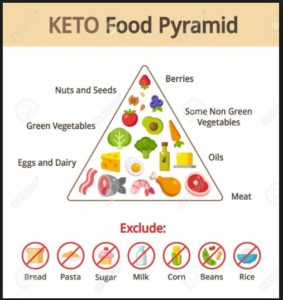
01 Feb The Keto Diet – Keep some Fat, Lose the Carbs
I don’t know about you but the word Keto has been flashing across my TV screen quite a bit. What is it really? Is it just a fad? Just the latest shiny thing that has the folks who are interested in weight-loss distracted again with a “new way”? Weight-loss can indeed be a challenge for many people especially if a specific aliment or disorder is involved. But besides those things, it may be simpler than it seems. It all begins with “a will” and “a why”. I’m going to talk about that more later, but for now, what’s all the buzz about Keto? Well, it turns out the Keto diet is a little more involved of a process than what some of its advocates let on.
The Ketogenic Diet (or Keto Diet, for short) is a low-carbohydrates, high fat diet that shares many similarities with Atkins and other low-carb diets. The thought here is to drastically reduce the carb intake and replace it with fat. Yes, you read that right. Massively reduce the carbs and replace it with fat. This is keto. The reduction in carbs puts your body in a metabolic state called ketosis. Something I found interesting is that ketosis actually has medical applications, for example, in serious cases of epilepsy. Dr. Adam L. Hartman, at The John M. Freeman Pediatric Epilepsy Center in Baltimore MD, in his book “Clinical Aspects of the Ketogenic Diet”, sites how doctors can use the ketogenic diet as a medical intervention in cases of intractable epilepsy. In its pages, he wrote: “The ketogenic diet remains a valuable therapeutic option for patients with intractable epilepsy. The diet has been used successfully in patients with many different epilepsy syndromes in countries around the world. Potential adverse effects can be avoided with careful attention during the diet’s initiation and maintenance phases. In the last decade, variations to the classical ketogenic diet have been utilized. Ketogenic diets now are being used for diseases other than epilepsy. This critical analysis of the diet should provide the impetus for further clinical and basic research into the diet’s application and mechanisms of action”. Basically, in the Keto diet, you’re shooting for a state; and from my experience in experimenting with food and its various affects on the body, this doesn’t just happen overnight.
If you’re wanting to use the keto methods for weight-loss, it can indeed prove to be very successful. This is because during ketosis your body becomes incredibly efficient at burning fat for energy. The break down of fatty acids into ketones is a natural normal process for everyone, but if you have achieved ketosis, you’re doing it on an elevated and incredibly effective level. Notice that I said, “if you have achieved ketosis”. If you decide to start this diet, stick to the regime and give your body time to adjust and achieve the ketosis state. Depending on the person this can take anywhere from 3 to 7 days. I would also suggest that you inform your primary care physician. I think it’s always good practice, when trying new diets with your body, to let your doctor know. You’ll take the diet more seriously and the doctor may be able to give you added advise and pointers. Ketogenic diets have been known to cause enormous reductions in blood sugar and insulin levels. This, along with the increased ketones, has many health benefits. The Keto diet has been lauded as having great benefits for heart disease, cancer, Alzheimer’s disease, epilepsy, Parkinson’s disease, polycystic ovary syndrome, brain injuries, and acne. Keep in mind, however, that the research into many of these areas are far from conclusive.
If you’re going to try the Keto diet, I wish you much success! Just stick to the regime and have fun! To help you along I’ll include a chart below that I found which details what should and should not be eaten. Write me and let me know how it’s going; I’d love to hear!

Standard ketogenic diet (SKD): This is a very low-carb, moderate-protein and high-fat diet. It typically contains 75% fat, 20% protein and only 5% carbs
Cyclical ketogenic diet (CKD): This diet involves periods of higher-carb refeeds, such as 5 ketogenic days followed by 2 high-carb days.
Targeted ketogenic diet (TKD): This diet allows you to add carbs around workouts.
High-protein ketogenic diet: This is similar to a standard ketogenic diet, but includes more protein. The ratio is often 60% fat, 35% protein and 5% carbs.
